Chapter: 11th Physics : UNIT 11 : Waves
Terms and Definitions Used in Wave Motion
TERMS
AND DEFINITIONS USED IN WAVE MOTION
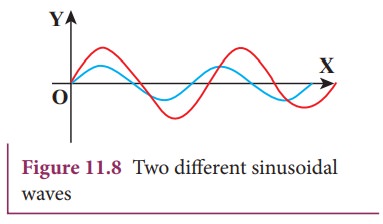
Suppose
we have two waves as shown in Figure 11.8. Are these two waves identical?. No.
Though, the two waves are both sinusoidal, there are many difference between
them. Therefore, we have to define some basic terminologies to distinguish one
wave from another.
Consider
a wave produced by a stretched string as shown in Figure 11.9.
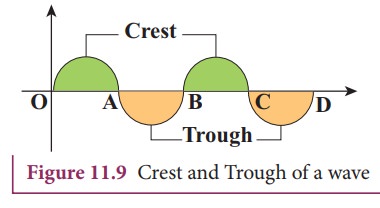
If
we are interested in counting the number of waves created, let us put a
reference level (mean position) as shown in Figure 11.9. Here the mean position
is the horizontal line shown. The highest point in the shaded portion is called
crest. With respect to the reference
level, the lowest point on the un-shaded portion is called trough. This wave contains repetition of a section O to B and hence
we define the length of the smallest section without repetition as one wavelength as shown in Figure 11.10. In
Figure 11.10 the length OB or length BD is one wavelengh. A Greek letter lambda
λ is used to denote one wavelength.
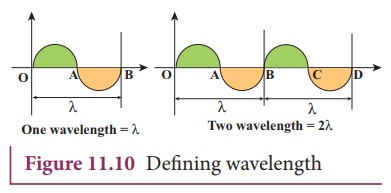
For
transverse waves (as shown in Figure 11.11), the distance between two
neighbouring crests or troughs is known as the wavelength.
For
longitudinal waves, (as shown in Figure 11.12) the distance between two
neighbouring compressions or rarefactions is known as the wavelength. The SI
unit of wavelength is meter.
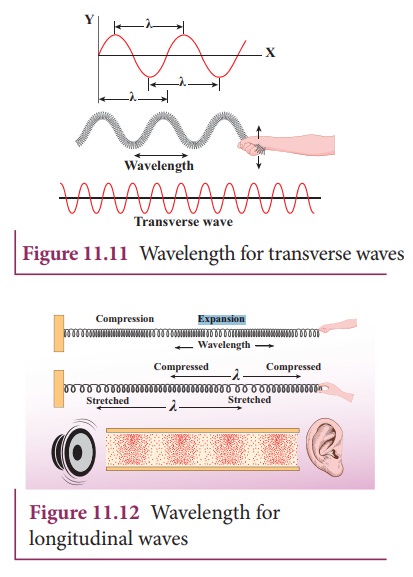
EXAMPLE 11.1
Which
of the following has longer wavelength?
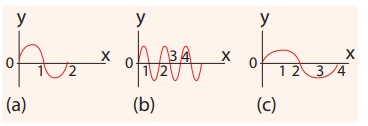
Answer is (c)
In
order to understand frequency and time period, let us consider waves (made of
three wavelengths) as shown in Figure 11.13 (a). At time t = 0 s, the wave reaches
the point A from left. After time t =
1 s (shown in figure 11.13(b)), the
number of waves which have crossed the point A is two. Therefore, the frequency
is defined as “the number of waves crossing a point per second” It is measured
in hertz whose symbol is Hz. In this example,
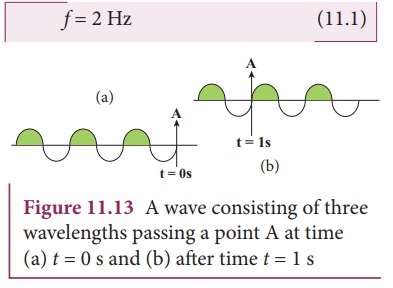
If
two waves take one second (time) to cross the point A then the time taken by
one wave to cross the point A is half a second. This defines the time period T
as

From
equation (11.1) and equation (11.2), frequency
and time period are inversely related i.e.,

Time period is defined as the time taken by one wave to cross a point.
EXAMPLE 11.2
Three
waves are shown in the figure below
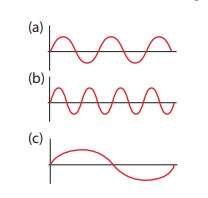
Write down
(a)
the frequency in ascending order
(b)
the wavelength in ascending order
Solution
(a)
fc < fa <
fb
(b)
λb < λa <
λc
From
the example 11.2, we observe that the frequency is inversely related to the
wavelength, f ∝
1/λ
Then,
fλ is equal to what?
[(i.e)
fλ=?]
A
simple dimensional argument will help us to determine this unknown physical
quantity.
Dimension
of wavelength is, [λ] = L
Frequency
f = 1/ Time period , which implies that the dimension of frequency is,
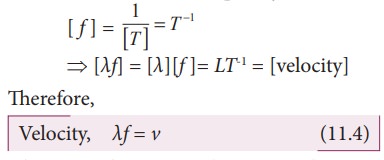
where
v is known as the wave velocity or phase velocity. This is the velocity with which the wave propagates. Wave
velocity is the distance travelled by a wave in one second.
Note:
1.
The number of cycles (or revolutions) per unit time is called angular frequency. Angular frequency, ω = 2π/T
= 2πf (unit is radians/second)
2.
The number of cycles per unit distance or number of waves per unit distance is
called wave number.
wave number, k = 2π/λ
(unit is radians/ meter)
In
two, three or higher dimensional case, the wave number is the magnitude of a
vector called wave vector. The points in space of wave vectors are called
reciprocal vectors, ![]() .
.
Dimensions
of ![]() is L-1.
is L-1.
The
velocity v, angular frequency ω and wave number λ are related as:

Wave
numbers and wave vectors play an essential role in optics and scattering
theory.
EXAMPLE 11.3
The
average range of frequencies at which human beings can hear sound waves varies
from 20 Hz to 20 kHz. Calculate the wavelength of the sound wave in these
limits. (Assume the speed of sound to be 340 m s-1.
Solution
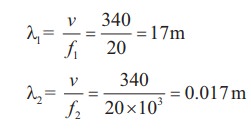
Therefore,
the audible wavelength region is from 0.017 m to 17 m when the velocity of
sound in that region is 340 m s-1.
EXAMPLE 11.4
A
man saw a toy duck on a wave in an ocean. He noticed that the duck moved up and
down 15 times per minute. He roughly measured the wavelength of the ocean wave
as 1.2 m. Calculate the time taken by the toy duck for going one time up and
down and also the velocity of the ocean wave.
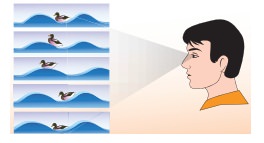
Solution
Given
that the number of times the toy duck moves up and down is 15 times per minute.
This information gives us frequency (the number of times the toy duck moves up
and down)

But
one minute is 60 second, therefore, expressing time in terms of second

The
time taken by the toy duck for going one time up and down is time period which
is inverse of frequency

The
velocity of ocean wave is v
v = λf = 1.2 ×0.25 = 0.3 m s-1.
Amplitude of a wave:
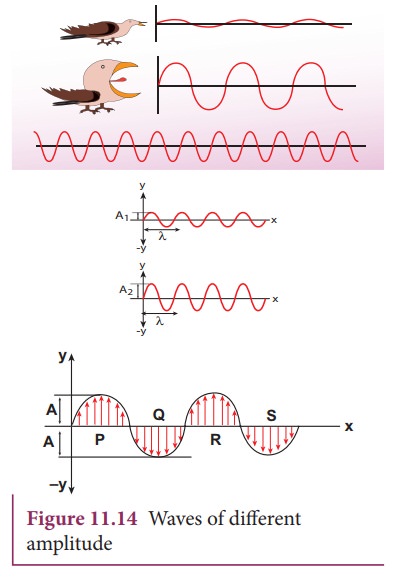
The
waves shown in the Figure 11.14 have same wavelength, same frequency and same
time period and also move with same velocity. The only difference between two
waves is the height of either crest or trough. This means, the height of the
crest or trough also signifies a wave character. So we define a quantity called
an amplitude of the wave, as the maximum displacement of the medium with
respect to a reference axis (for example in this case x-axis). Here, it is
denoted by A.
EXAMPLE 11.5
Consider
a string whose one end is attached to a wall. Then compute the following in
both situations given in figure (assume waves crosses the distance in one
second)
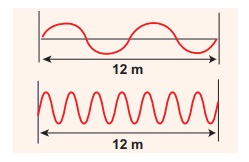
(a) Wavelength,
(b) Frequency and
(c) Velocity
Solution
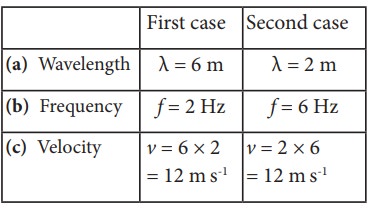
This
means that the speed of the wave along a string is a constant. Higher the
frequency, shorter the wavelength and vice versa, and their product is velocity
which remains the same.
Related Topics